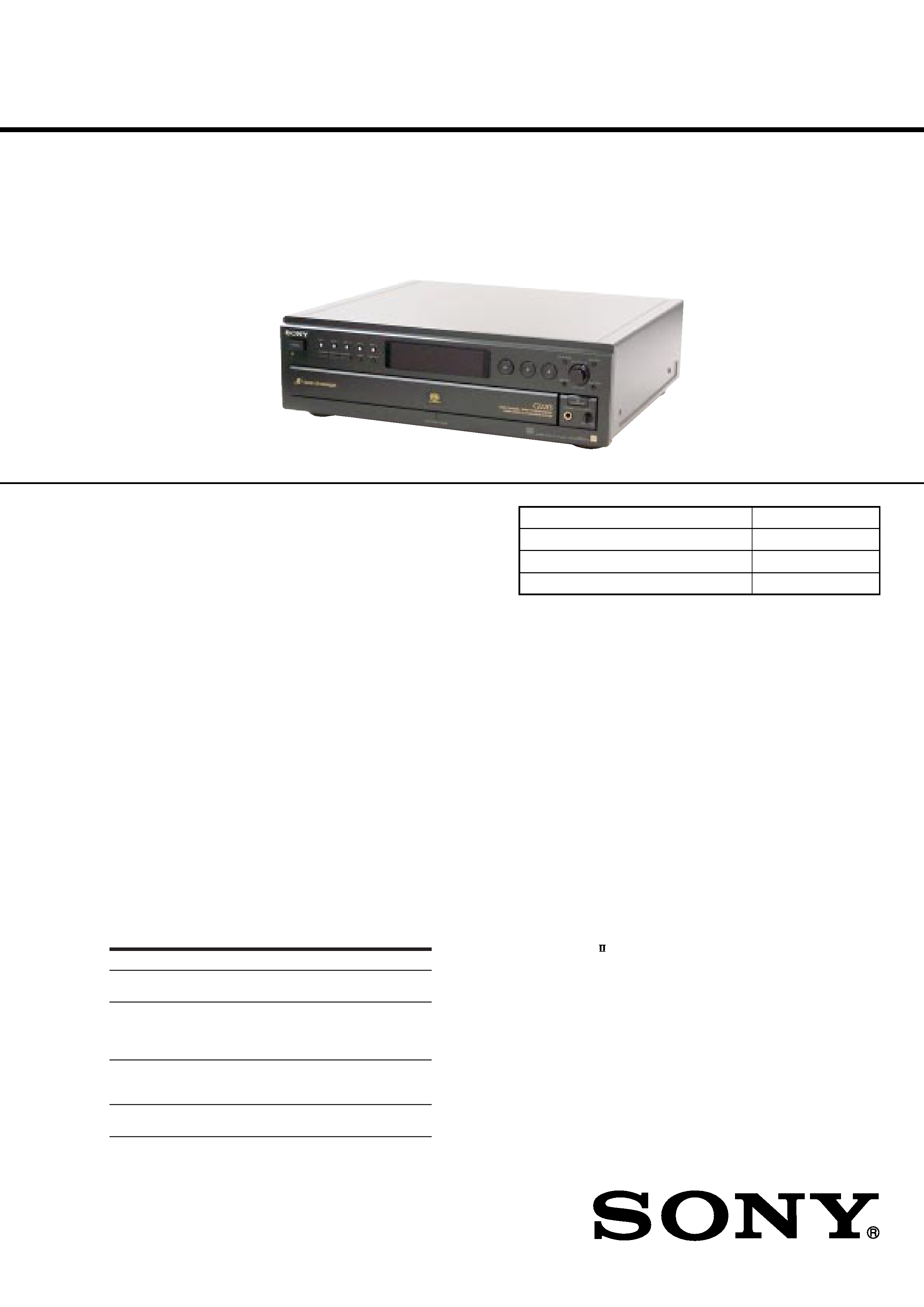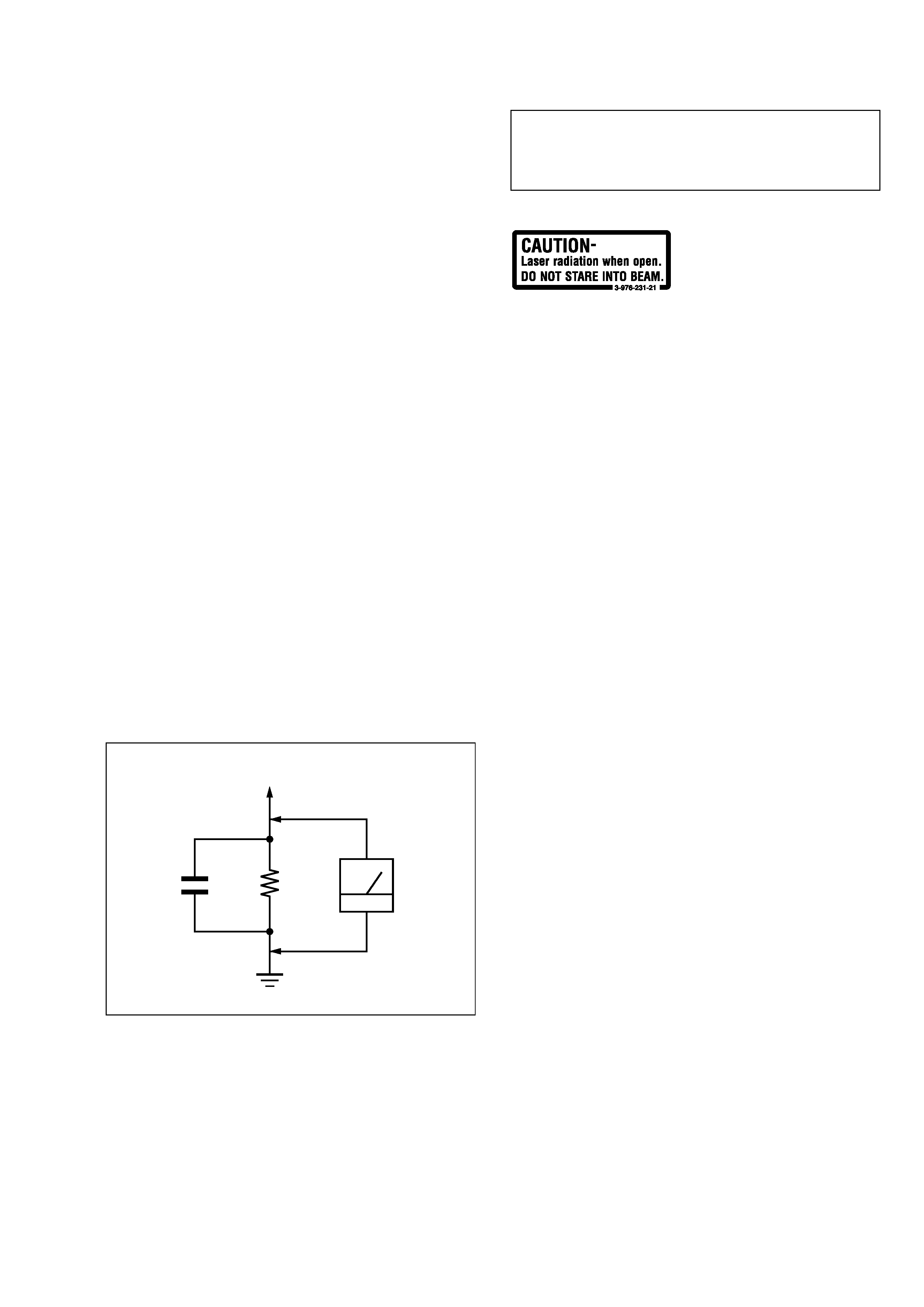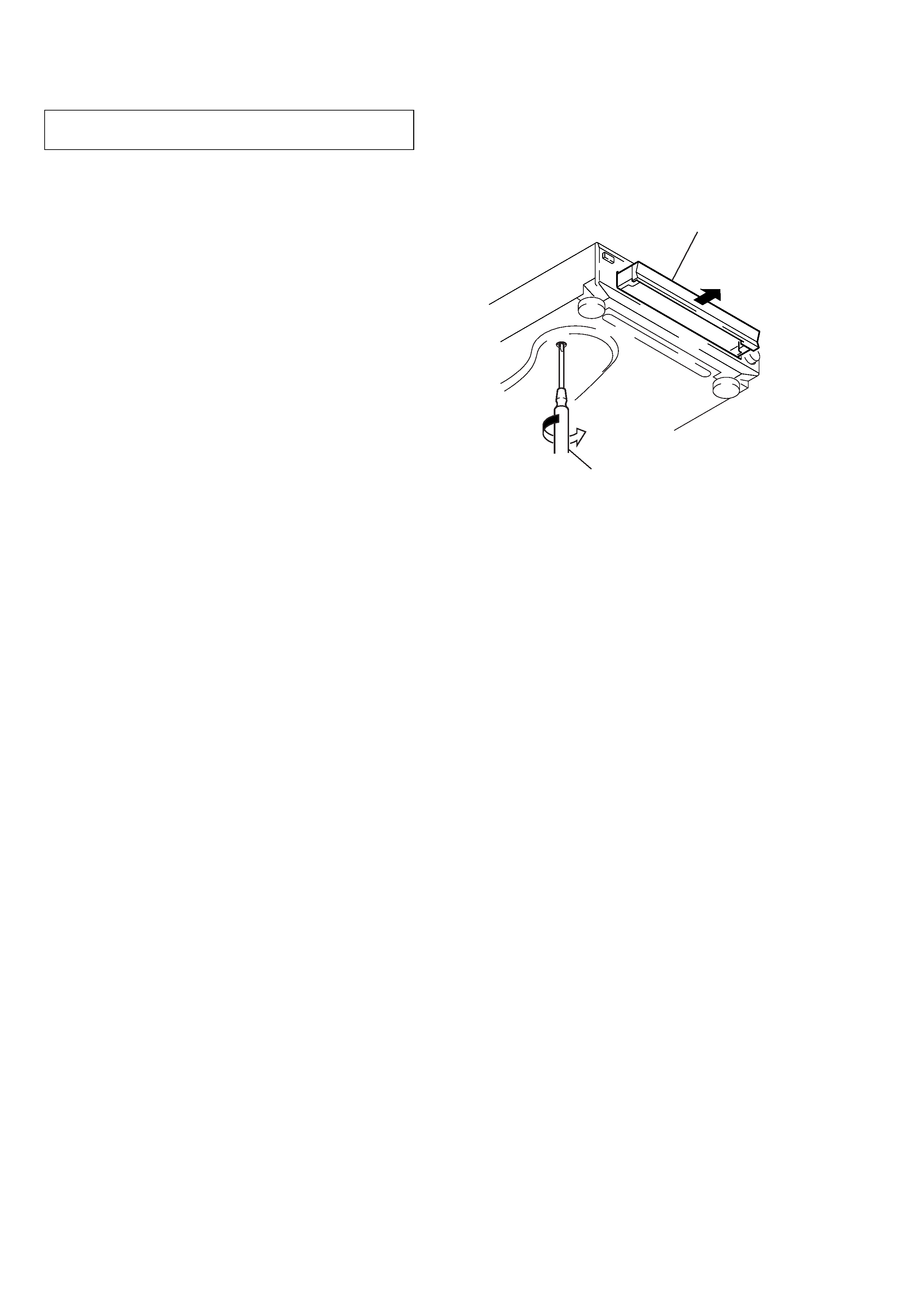
SERVICE MANUAL
SUPER AUDIO CD PLAYER
US Model
Canadian Model
SCD-C222ES
Ver 1.0 2001.07
SPECIFICATIONS
Model Name Using Similar Mechanism
SCD-CE775
CD Mechanism Type
CDM59A-DVBU5A
Base Unit Name
DVBU5A
Optical Pick-up Name
KHM-230AAA
9-873-158-01
Sony Corporation
2001G0500-1
Home Audio Company
C
2001.7
Shinagawa Tec Service Manual Production Group
When a super audio CD is played
Playing frequency range
2 Hz to 100 kHz
Frequency response
2 Hz to 50 kHz (3 dB)
Dynamic range
104 dB or more
Total harmonic distortion rate
0.0018 % or less
Wow and flutter
Value of measurable limit (
±0.001 %
W. PEAK) or less
When a CD is played
Frequency response
2 Hz to 20 kHz
Dynamic range
99 dB or more
Total harmonic distortion rate
0.0020 % or less
Wow and flutter
Value of measurable limit (
±0.001 %
W. PEAK) or less
Output connector
Jack type Output level
Load impedance
ANALOG OUT Phono
2 Vrms
Over 10 kilohms
jacks
(at 50 kilohms)
DIGITAL (CD)
Square
18 dBm
OUT OPTICAL* optical
output
connector
DIGITAL (CD)
Coaxial
0.5 Vp-p
75 ohms
OUT COAXIAL* output
connector
PHONES
Stereo
10 mW32 ohms
phone jack
*Output only the audio signals of the CD
Lightemitting
wave length:
660 nm
(
)
General
Laser
Semiconductor laser
(SACD:
= 650 nm)
(CD:
= 780 nm)
Emission duration:continuous
Power requirements
120 V AC, 60 Hz
Power consumption
26 W
Dimensions (w/h/d)
430
× 135 × 400 mm
(17
× 4 1/4 × 15 3/4in.)
incl. projecting parts
Mass (approx.)
7.5 kg (16 lbs 9 oz.)
Supplied accessories
· Audio connecting cord
phono jack
× 2 (Red and White) y phono jack × 2 (Red
and White) (2)
phono jack
× 1 (Black) y phono jack × 1 (Black) (2)
· Monaural (2P) mini-plug cord (1) (Connecting cord for
CONTROL A1
)
· Remote commander (remote) RM-SC500 (1)
· R6 (size-AA) batteries (2)
and White) (2)
Design and specifications are subject to change withoutnotice.

2
SCD-C222ES
TABLE OF CONTENTS
1.
SERVICING NOTES ............................................... 4
2.
GENERAL ................................................................... 6
3.
DISASSEMBLY
3-1. Disassembly Flow ...........................................................
8
3-2. Case .................................................................................
9
3-3. Front Panel Section .........................................................
9
3-4. CD Mechanism Deck (CDM59A-DVBU5A) ................ 10
3-5. AUDIO Board ................................................................. 10
3-6. POWER Board ................................................................ 11
3-7. MAIN Board ................................................................... 11
3-8. Base Unit (DVBU5A) ..................................................... 12
3-9. Table Assy ....................................................................... 12
3-10. SENSOR Board ............................................................... 13
3-11. LOADING MOTOR Board ............................................ 13
4.
ASSEMBLY ................................................................. 14
5.
TEST MODE .............................................................. 15
6.
DIAGRAMS
6-1. Block Diagram RF/SERVO Section ........................ 30
6-2. Block Diagram SERVO Section .............................. 31
6-3. Block Diagram MAIN Section ................................ 32
6-4. Block Diagram AUDIO Section .............................. 33
6-5. Block Diagram DISPLAY/KEY CONTROL/
POWER SUPPLY Section ........................................... 34
6-6. Note for Printed Wiring Boards and
Schematic Diagrams ....................................................... 35
6-7. Printed Wiring Board RF Board .............................. 36
6-8. Schematic Diagram RF Board ................................. 37
6-9. Printed Wiring Boards
MOTOR/SENSOR Section ....................................... 38
6-10. Schematic Diagram MOTOR/SENSOR Section .... 39
6-11. Printed Wiring Board
MAIN Board (Component Side) .............................. 40
6-12. Printed Wiring Board
MAIN Board (Conductor Side) ................................ 41
6-13. Schematic Diagram MAIN Board (1/5) ................. 42
6-14. Schematic Diagram MAIN Board (2/5) .................. 43
6-15. Schematic Diagram MAIN Board (3/5) .................. 44
6-16. Schematic Diagram MAIN Board (4/5) .................. 45
6-17. Schematic Diagram MAIN Board (5/5) .................. 46
6-18. Schematic Diagram
AUDIO/HEADPHONE Boards ................................ 47
6-19. Printed Wiring Board
AUDIO Board (Component Side) ............................ 48
6-20. Printed Wiring Boards AUDIO (Conductor Side)/
HEADPHONE Boards ................................................. 49
6-21. Printed Wiring Boards
DISPLAY/KEY/LED/RM Boards ............................ 50
6-22. Schematic Diagram
DISPLAY/KEY/LED/RM Boards ............................ 51
6-23. Printed Wiring Boards POWER/REG Boards ......... 52
6-24. Printed Wiring Boards POWER SW/PT Boards ..... 53
6-25. Schematic Diagram
POWER/POWER SW/PT/REG Boards ................... 54
6-26. IC Pin Function Description ........................................... 63
7.
EXPLODED VIEWS
7-1. Case Section .................................................................... 79
7-2. Front Panel Section ......................................................... 80
7-3. Chassis Section ............................................................... 81
7-4. CD Mechanism Deck Section-1
(CDM59A-DVBU5A) ..................................................... 82
7-5. CD Mechanism Deck Section-2
(CDM59A-DVBU5A) ..................................................... 83
7-6. Base Unit Section (DVBU5A) ........................................ 84
8.
ELECTRICAL PARTS LIST ............................... 85

3
SCD-C222ES
This label is located on the LEFT exterior.
Notes on chip component replacement
· Never reuse a disconnected chip component.
· Notice that the minus side of a tantalum capacitor may be dam-
aged by heat.
Flexible Circuit Board Repairing
· Keep the temperature of the soldering iron around 270 °C dur-
ing repairing.
· Do not touch the soldering iron on the same conductor of the
circuit board (within 3 times).
· Be careful not to apply force on the conductor when soldering
or unsoldering.
CAUTION
Use of controls or adjustments or performance of procedures
other than those specified herein may result in hazardous ra-
diation exposure.
SAFETY CHECK-OUT
After correcting the original service problem, perform the follow-
ing safety check before releasing the set to the customer:
Check the antenna terminals, metal trim, "metallized" knobs,
screws, and all other exposed metal parts for AC leakage.
Check leakage as described below.
LEAKAGE TEST
The AC leakage from any exposed metal part to earth ground and
from all exposed metal parts to any exposed metal part having a
return to chassis, must not exceed 0.5 mA (500 microamperes.).
Leakage current can be measured by any one of three methods.
1. A commercial leakage tester, such as the Simpson 229 or RCA
WT-540A. Follow the manufacturers' instructions to use these
instruments.
2. A battery-operated AC milliammeter. The Data Precision 245
digital multimeter is suitable for this job.
3. Measuring the voltage drop across a resistor by means of a
VOM or battery-operated AC voltmeter. The "limit" indica-
tion is 0.75 V, so analog meters must have an accurate low-
voltage scale. The Simpson 250 and Sanwa SH-63Trd are ex-
amples of a passive VOM that is suitable. Nearly all battery
operated digital multimeters that have a 2 V AC range are suit-
able. (See Fig. A)
Fig. A.
Using an AC voltmeter to check AC leakage.
1.5 k
0.15
µF
AC
voltmeter
(0.75 V)
To Exposed Metal
Parts on Set
Earth Ground
ATTENTION AU COMPOSANT AYANT RAPPORT
À LA SÉCURITÉ!
LES COMPOSANTS IDENTIFIÉS PAR UNE MARQUE 0
SUR LES DIAGRAMMES SCHÉMATIQUES ET LA LISTE
DES PIÈCES SONT CRITIQUES POUR LA SÉCURITÉ
DE FONCTIONNEMENT. NE REMPLACER CES COM-
POSANTS QUE PAR DES PIÈCES SONY DONT LES
NUMÉROS SONT DONNÉS DANS CE MANUEL OU
DANS LES SUPPLÉMENTS PUBLIÉS PAR SONY.
SAFETY-RELATED COMPONENT WARNING!!
COMPONENTS IDENTIFIED BY MARK 0 OR DOTTED
LINE WITH MARK 0 ON THE SCHEMATIC DIAGRAMS
AND IN THE PARTS LIST ARE CRITICAL TO SAFE
OPERATION. REPLACE THESE COMPONENTS WITH
SONY PARTS WHOSE PART NUMBERS APPEAR AS
SHOWN IN THIS MANUAL OR IN SUPPLEMENTS PUB-
LISHED BY SONY.

4
SCD-C222ES
The laser diode in the optical pick-up block may suffer electro-
static break-down because of the potential difference generated
by the charged electrostatic load, etc. on clothing and the human
body.
During repair, pay attention to electrostatic break-down and also
use the procedure in the printed matter which is included in the
repair parts.
The flexible board is easily damaged and should be handled with
care.
NOTES ON LASER DIODE EMISSION CHECK
The laser beam on this model is concentrated so as to be focused
on the disc reflective surface by the objective lens in the optical
pick-up block. Therefore, when checking the laser diode emis-
sion, observe from more than 30 cm away from the objective lens.
LASER DIODE AND FOCUS SEARCH OPERATION
CHECK
Carry out the "S curve check" in "CD section adjustment" and
check that the S curve waveforms is output three times.
CLEANING OF OPTICAL PICK-UP LENS
In cleaning the lens of optical pick-up, use the air blower.
Never use a cotton swab for cleaning the lens of optical pick-up,
which otherwise causes a trouble.
CHECKING SIGNALS OF CD SECTION
Efficiency to check each signal of CD section is increased when
the test points on the MAIN board are used.
Refer to 5-8. WAVEFORMS CHECK (page 27)
NOTES ON HANDLING THE OPTICAL PICK-UP
BLOCK OR BASE UNIT
SECTION 1
SERVICING NOTES
table
tapering driver
* To close the disc table, turn the tapering
driver in the reverse direction (to IN direction).
HOW TO OPEN THE DISC TABLE WHEN POWER
SWITCH TURNS OFF
Insert a tapering driver into the aperture of the unit bottom, and
turn it in the direction of the arrow (to OUT direction).

5
SCD-C222ES
RESETTING OPERATION AT POWER ON
If the power is turned on with a disc loaded in the set, a sequence of operation as shown below will be performed.
(The operation varies depending on the type of disc)
Condition: continue mode
(1) CD
1.
Sled reverse move (sled in)
2.
Disc detect
3.
IC setting for CD
4.
Servo error signal offset auto adjustment
5.
Spindle kick for LD on
6.
LD on
7.
Focus search
8.
Focus servo on
9.
Spindle kick
10. Spindle servo on
11. E-F balance auto adjustment
12. Tracking & sled servo on
13. Focus bias auto adjustment
14. Focus servo gain auto adjustment
15. Tracking servo gain auto adjustment
16. Jump to lead-in area
17. Read TOC
18. Stop
(2) SACD (single layer)
1.
Sled reverse move (sled in)
2.
Disc detect
3.
IC setting for SACD
4.
Servo error signal offset auto adjustment
5.
Spindle kick for LD on
6.
LD on
7.
Focus search
8.
Focus servo on
9.
Spindle kick
10. Spindle servo on
11. E-F balance auto adjustment
12. Tracking & sled servo on
13. Focus bias auto adjustment
14. Focus servo gain auto adjustment
15. Tracking servo gain auto adjustment
16. Jump to lead-in area
17. Read TOC
18. Stop
(3) SACD (dual layer)
1.
Sled reverse move (sled in)
2.
Disc detect
3.
IC setting for SACD
4.
Servo error signal offset auto adjustment
5.
Spindle kick for LD on
6.
LD on
7.
Focus search
8.
Focus servo on (layer 0)
9.
Spindle kick
10. Spindle servo on
11. E-F balance auto adjustment (layer 0)
12. Tracking & sled servo on (layer 0)
13. Focus bias auto adjustment (layer 0)
14. Focus servo gain auto adjustment (layer 0)
15. Tracking servo gain auto adjustment (layer 0)
16. Jump to lead-in area
17. Read TOC
18. Focus jump (layer 0
tlayer 1)
19. E-F balance auto adjustment (layer 1)
20. Tracking & sled servo on (layer 1)
21. Focus bias auto adjustment (layer 1)
22. Focus servo gain auto adjustment (layer 1)
23. Tracking servo gain auto adjustment (layer 1)
24. Focus Jump (layer 1
tlayer 0)
25. Stop
